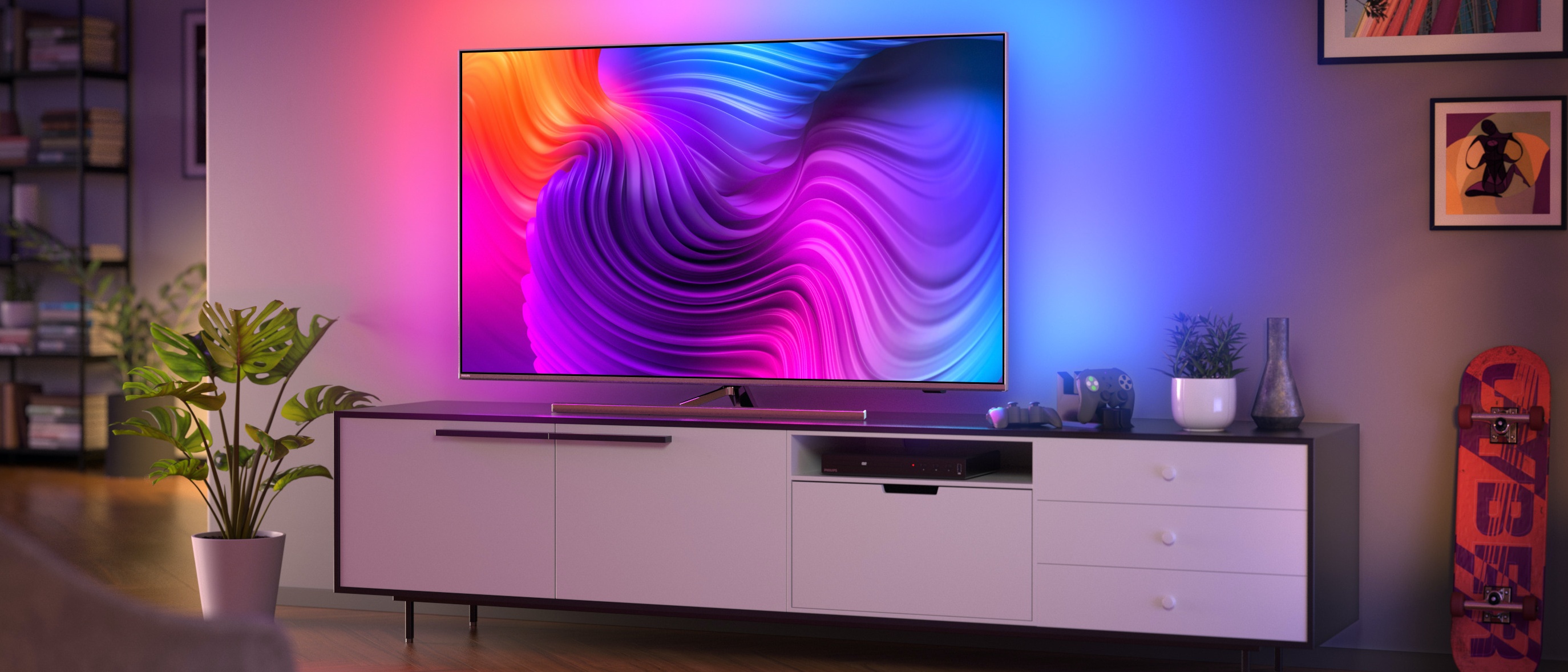TechRadar Verdict
For those boggled by the amount of choice and acronyms now involved when buying a TV, the Philips PUS8506 aims to simplify the whole process with a set that provides a good picture, decent sound and easy connectivity at a great mid-range price – not to mention all the joys of Ambilight too. It isn’t a set that’s going to worry the flagship TVs out there, but the majority of buyers will find this TV a superb all-round package.
Pros
- +
Superb value for money
- +
Decent built-in sound
- +
Ambilight is gorgeous
Cons
- -
Narrow viewing angles
- -
Poor shadows and highlights
- -
Design is a mixed bag
Why you can trust TechRadar
Two-minute review
The Philips PUS8506 is the 2021 edition of The One – a range started a couple of years ago to take the confusion out of the TV buying process – and it's a strong all-rounder in terms of specs and performance.
The 58-inch set that we tested sits in the middle of the range of screen sizes available, and comes with an attractive central metal stand that swivels to give some flexibility on placement. The design isn’t all good though: the bezel that frames the TV is silver to match the stand, which actually highlights its slightly chunkier-than-average appearance – we’d prefer it if it was black.
At 8cm deep, wall mounting might be off the menu unless you don’t mind your TV standing a little proud from the wall. Ambilight is one of the reasons for this bulk of course, and you get it in its three-sided iteration here. As always, it looks gorgeous and is a big plus point for Philips TVs.
Once again, Android TV is the UI of choice here. It’s not the best laid out smart TV system, but it’s much improved from before, and quicker too. Most importantly, the app provision is good. Freeview Play is on board for all the UK’s catch-up services, plus there’s most of the on-demand video you’d want to see, including Netflix, Amazon Prime Video and Disney+.
Getting the TV set up can take some time if you’re a fan of picture tweaking – there are a lot of options to go through here, and it can feel a little overwhelming at times. Still, once you’ve found a balance that works for your tastes, there’s a lot to like.
In 4K HDR (of which, this TV supports both HDR10+ and Dolby Vision, as well as HDR10 and HLG), colours are beautifully handled, detail retrieval is admirable and outlines are crisp and sharp. Contrast is great too, though when watching HDR content there is some loss of shadow and highlight detail as the set looks to get as dark and bright as possible.
Upscaling is handled well by the set’s P5 processor, and HD content retains a lot of the same qualities as 4K footage, with punchy, vibrant colours, superb detail and good contrast. There is a touch of noticeable noise, particularly in streamed content, but it’s still a very enjoyable watch indeed.
Sign up for breaking news, reviews, opinion, top tech deals, and more.
SD content doesn’t fair quite so well, and is noticeably softer with more noise and some visible banding. We’re happy to see the PUS8605 has a solid grip on motion though, and everything from fight scenes to fast camera pans are smooth and judder-free.
Sound is handled by two 10w downward firing speakers, which go loud enough, and there’s plenty of clarity to voices too. Bass is on the soft side though, and it doesn’t have the detail or dynamics to hold its own next to a soundbar. Dolby Atmos sound is built in but you won’t really hear its benefits from the built in speakers. If you can, an upgrade to a soundbar will be well worth it.
For gamers, there is VRR support on HDMI1 and HDMI2 for smooth gameplay, though with input lag sitting at around 21ms, more serious gamers will probably want to look elsewhere, however.
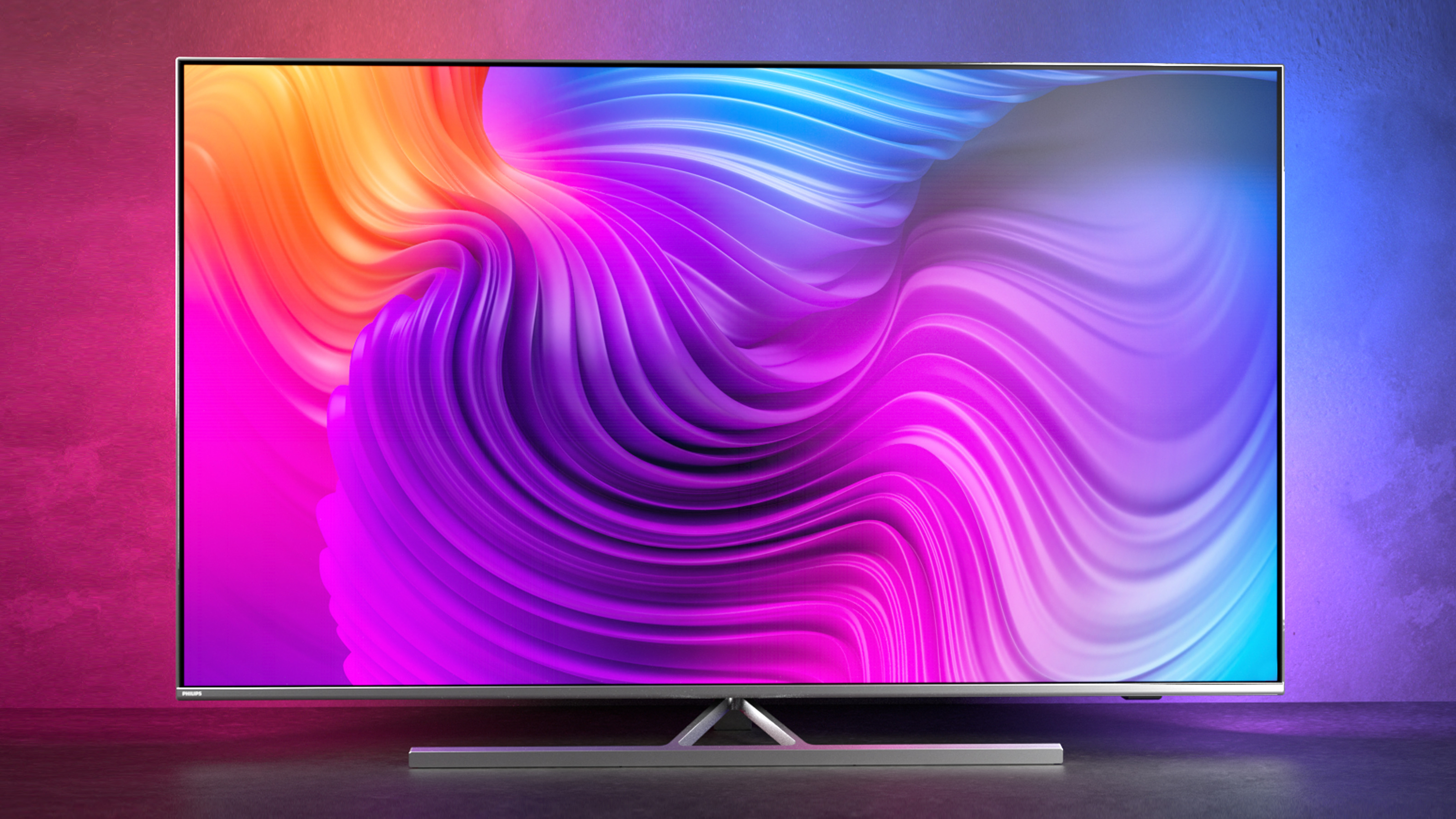
Philips PUS8506 price and availability
With a name like “The One”, the Philips PUS8506 really needed to come in a range of screen sizes to ensure it fits the bill for as many people as possible. And with five screen sizes to choose from, it should have most situations that covered.
It’s available in the UK only in 43-inch (£649), 50-inch (£699), 58-inch (£829), 65-inch (£949) and 70-inch (£1099) sizes. A 75-inch version is listed as available on the Philips website, but we weren’t able to find it for sale anywhere at the time of writing.
These prices are a little higher than this range launched at last year – around £120 - £150 more depending on the size screen you’d like – but there have been some notable improvements that could account for that.
Design
- Silver bezels aren’t to all tastes
- Central swivel stand
- Three-sided Ambilight
The Philips PUS8506 aims to please with its easy-to-accommodate design. It’s no huge departure from the design we’ve seen in this range for the past couple of years, meaning it has similarly good and bad points.
Unlike some mid-range competitors, the central stand here is made from metal with a brushed matte finish. It swivels 15 degrees on either side to allow you to adjust your viewing angles with ease, which helps with placement. The fact that the stand is located in the centre also makes it easy to accommodate on smaller TV units (though it’s worth noting that the 70-inch and 75-inch models are pictured with a two-feet stand, which will require something larger).
If you prefer, you can always mount it on the wall – the 58-inch version that we tested is compatible with VESA wall mounts 200 x 300mm. However, the PUS8506 is on the chunkier side at almost 8cm deep, so will stand a little proud from the wall if this is the route you choose.
The TV itself is well made, but parts of it don’t look the most premium. For example, its bezels are silver to match the stand, and while they aren’t actually overly thick, the fact they’re silver makes them stand out from the screen like a frame. We prefer the more subtle finish offered by a black bezel, but it’s not a deal breaker.
Around the back there are four HDMI inputs (2 x 2.1 and 2 x 2.0) – one of which is side mounted for easy access, two USB inputs (one also side mounted), satellite and aerial connections, a digital optical out and a headphone out. ARC is supported across all HDMI inputs, with eARC on HDMI2.
There is wi-fi built in, but also an ethernet port for hardwiring, as well as Bluetooth 5.0.
You’ll find one remote included in the box, and a pretty sizeable one at that. It’s well made and responsive, but the empty space towards the bottom does feel like it could be made a touch smaller to avoid the need to reach for buttons at the top. Particularly when that’s where the shortcut buttons are for accessing Netflix, Prime Video, Rakuten TV and the TV’s Ambilight settings.
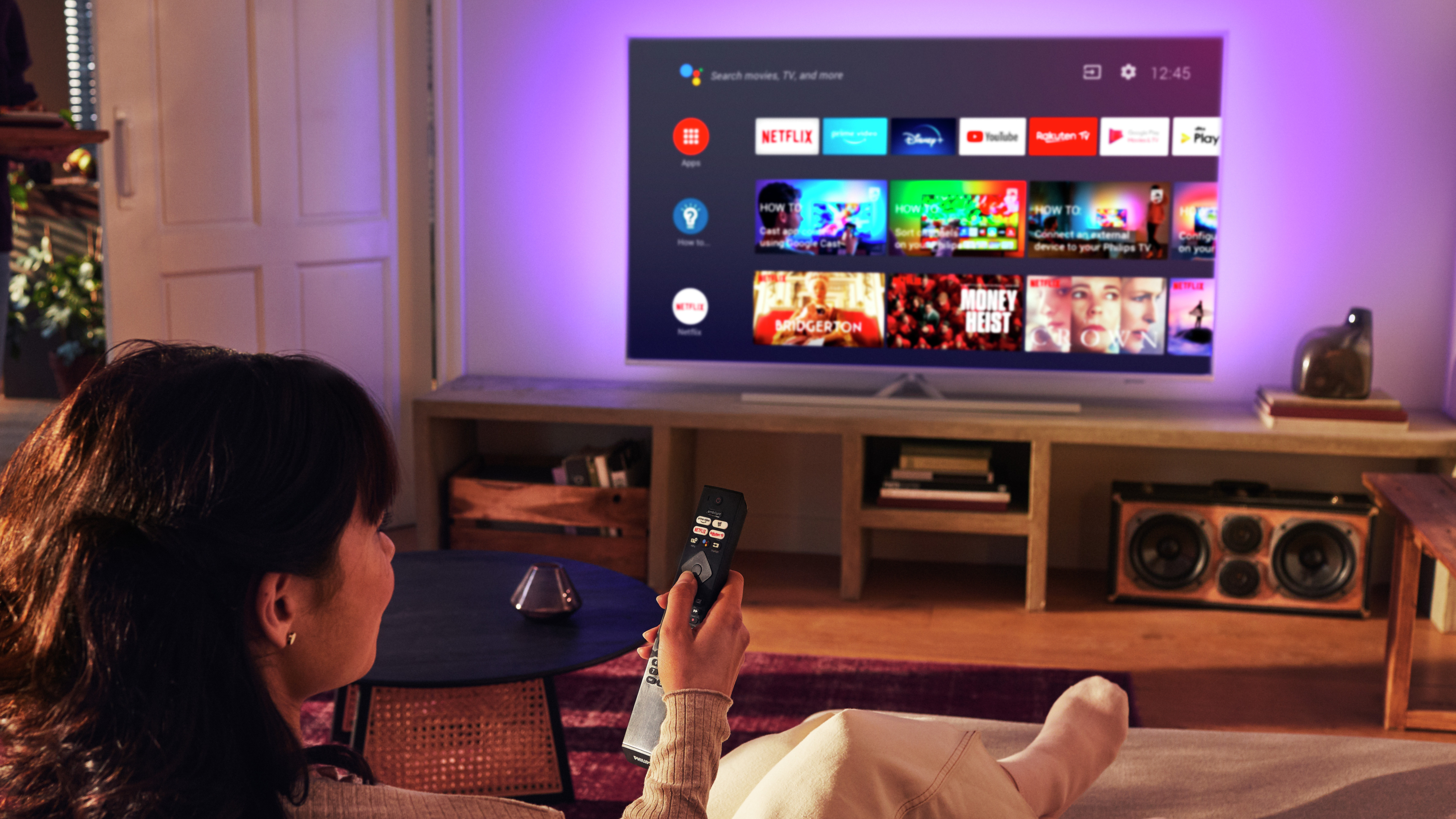
Ambilight remains a real treat on Philips sets, and a big reason to opt for one of its TVs over any other manufacturer. Not only does it look great, but so-called bias lighting actually reduces eye strain when watching a TV in a darkened room, helping those movie marathons to be a little more comfortable.
The PUS8506 has it around three sides (top, left and right), and can be configured to suit your tastes. We like the added immersion it adds when set to follow the video, so the colours mimic what’s showing on screen. You even adjust the tone of the colours that are shown with this setting too – we like standard but you can choose from others including vivid, natural, relax, comfort, football and game.
Other options include having Ambilight follow the audio, which has some great colour options for parties, or to keep it simple by following a colour, which offers a more static single colour behind the display.
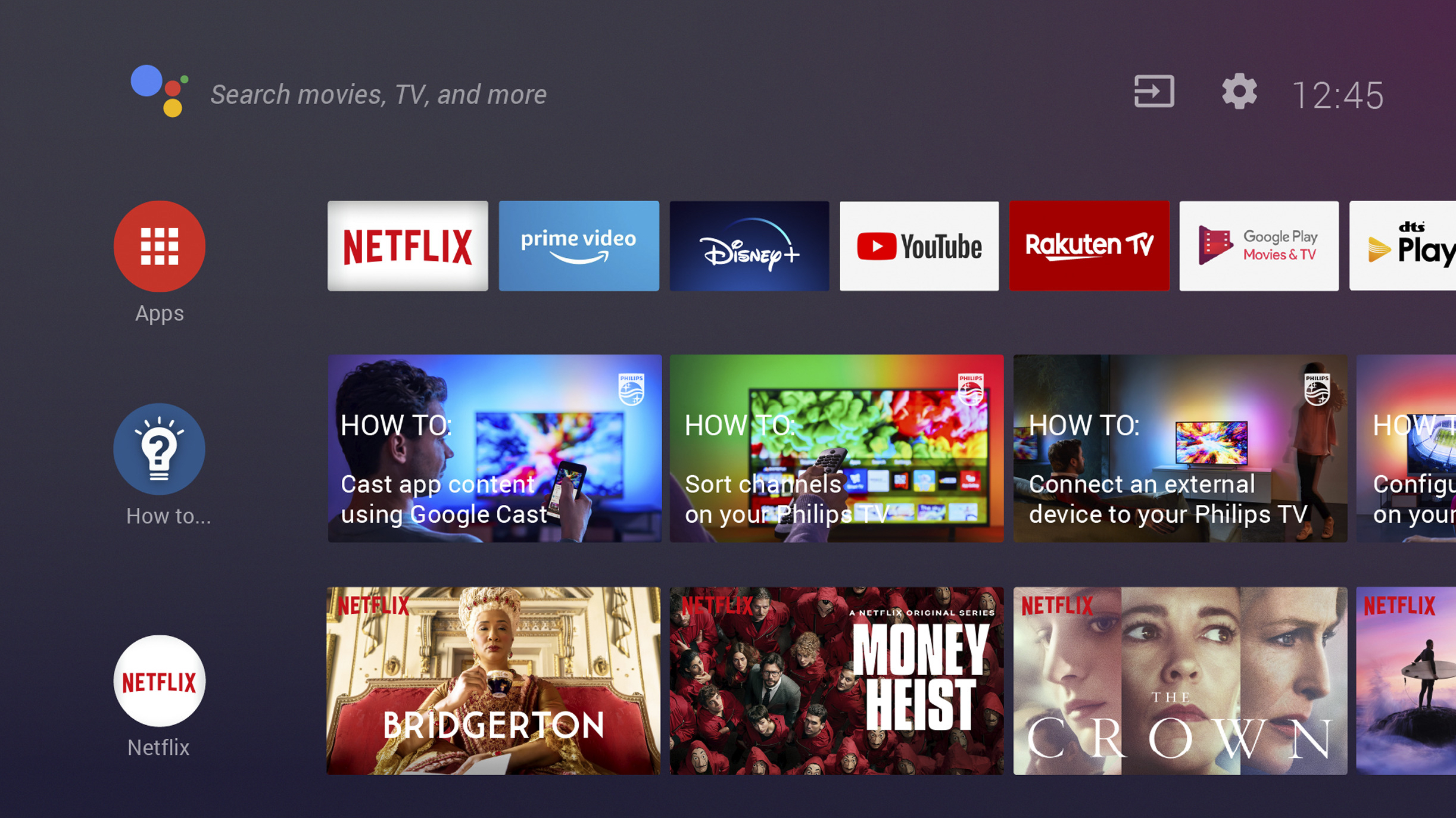
Smart TV (Android TV)
- Android TV 10
- Good app selection including Freeview Play
- Menus are a little longwinded
The PUS8506 uses Android TV 10 as its UI, and while it hasn’t jumped across to the newer, fresher Google TV interface as yet (and we’re not sure if it will be upgraded in the future), the improved design of Android TV ensures you don’t feel too left out.
The interface is clean and easy enough to navigate. It’s not the most intuitive, nor the most clearly laid out but it’s really not the clunky experience that you may have seen before – it’s much smoother and faster than the Android TV of yore.
Content is arranged in customisable carousels, with your list of apps along the top and then “channels” for each app underneath it, such as Netflix or Prime Video. In these carousels you’ll find suggested content for you to dive into straight from the home screen. I’m not convinced the recommendations are as personalised to your viewing habits as you’ll find on something like Samsung’s interface, but that’s really our only niggle.
App selection is good too. You’ll find all the UK’s catch up apps, including BBC iPlayer, ITV Hub, All 4 and My5, thanks to Freeview Play integration, plus the likes of Netflix, Amazon Prime Video and Disney+ – all in their 4K iterations.
As an Android TV, Chromecast functionality comes as standard, so you can fling content from your phone to your TV with wanton abandon. Google Assistant is also available for voice assistance – you can use it to adjust your TV settings and move around channels or to search for and load content. Not all apps work with it, but Netflix does, so you can navigate to any Netflix content just using your voice.
What is a bit clunky, is the way Android TV and Philips’ own UI for TV settings are integrated, as they are basically two separate entities that sit alongside one another, and switching between them can feel a bit disjointed.
Philips’ own menus are a little drawn out and complicated too, such is their comprehensive offering for tweaking. Thankfully, each menu option gives a short explanation of what changing that setting can do, as there are several that sound like they do similar things, or that have different names in other systems. Having the ability for such careful customisation is great for those who like that, but the various TV modes (Standard, Vivid, Movie, ISF Day, ISF Night etc) come with suggested default settings that can help those with less know how adjust their TV’s picture to their tastes.

Picture quality
- Both HDR10+ and Dolby Vision supported
- Stable motion handling
- Some loss of shadow and highlight detail
Let’s cut to the chase – the PUS8605 offers a great picture for the money. This is a midrange set, so it isn’t going to bother the likes of the OLEDs and flagship LCDs, nor is it aiming to. Its focus is creating an enjoyable picture that’s going to appeal to the majority of TV buyers. That means sharp outlines, punchy colours and good contrast are top of the bill, to create as striking a picture as possible for the price.
This is all in the hands of the Philips P5 processor, which focuses on the five areas that the company believes make a great TV picture – source perfection, sharpness, colour, contrast and motion.
As you’d expect, this is most evident with 4K HDR content, which looks fantastic when watching an episode of Squid Games on Netflix. This set supports both HDR10+ and Dolby Vision (as well as HDR 10 and HLG) and the Dolby Vision content from Netflix is flagged immediately, with the HDR-specific picture settings loading up automatically.
In terms of settings, we opt for Dolby Vision Bright for a good balance of punch and realism. Even when watching at night, we preferred the added brightness from this setting that the Dolby Vision Dark profile can’t quite muster, to give a more convincing HDR impact. As a mid-range panel, its peak brightness is on the humble side, so a helping hand here to make the most of its capabilities is appreciated.
HDR Personal is brighter still, but offers a distinctly cooler image, with a bluey tinge that we found off putting and overly stark.
Interestingly, and despite the HDR Vivid setting on most TVs usually being a big no-no from a reviewer’s perspective, it’s actually not too bad here, and worth a look if you like your pictures with real punch. While colours are certainly bolder than is natural, it gives a richness to HDR images that can work really well with movies… just don’t even think about it for SDR content.
No matter which picture setting you go for, we’d recommend switching off most of the extra processing or setting it to low, and adjusting from there if you need to – apart from motion processing, which you’ll want to switch on.
Philips hasn’t always been the best in this area, compared with the competition, but it’s starting to come close more recently. It’s a little complicated to get the desired result, thanks to one too many options to choose from, but overall we liked the results from the Movie setting, which helped to smooth out a judder-y fight scene in Squid Games episode 1. Philips’ new Pure Cinema Motion is also worth a look, but it looked overly smooth to us on occasion, and overall less natural.
With all settings tweaked to our preferences, the image from the PUS8506 is really enjoyable to watch. Colours are rich, detail retrieval is fantastic and edges are crisp and well defined. Contrast is really impactful too, with inky deep blacks and HDR highlights that pack a punch, with little-to-no blooming.
However, there is some loss of detail in the darkest and brightest areas of a picture, and sometimes darker scenes can lack the definition that pricier sets can manage, including Philips’ own OLED806. Off-axis viewing leaves a little to be desired too, with blacks losing depth and colours losing saturation, so straight on viewing is definitely the way to go with this TV. Thankfully the swivel stand can help if you’re seated just a little off centre, but won’t help if you have a room full of people watching from all different angles.
Switching up to SDR content and we found the ISF Day or Movie settings gave the best balance, the former offering a bit more brightness to the picture once again, though if you’re craving more punch, Natural is worth a look too. Whatever you do, steer clear of Standard mode – it’s effectively the set’s Eco mode and is not set up with picture quality in mind.
Upscaling is well handled on the PUS8506, and HD content watched on Sky is sharp and largely clear of noise. You might spot some creeping in on streamed content, but it’s minimal and doesn’t distract from an otherwise accomplished picture that shares the same qualities as its 4K performance – superb colour handling, excellent detail levels and impactful contrast.
Even SD broadcast footage fairs pretty well if you must, though it is noticeably softer. You will see noise increase significantly and spot some banding creeping in too, so it’s best to stick to HD and above where you can.
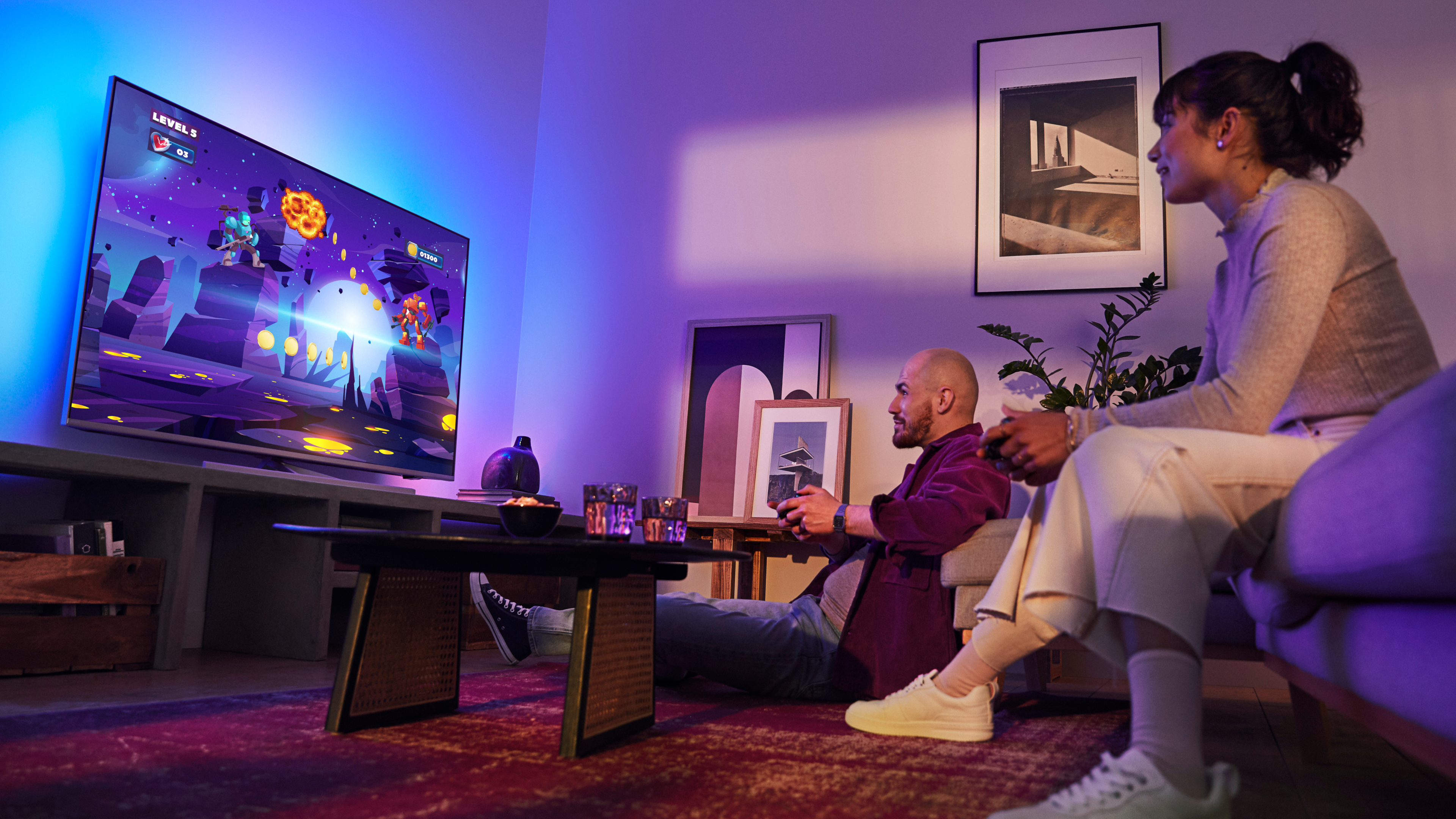
Audio and gaming performance
While pricier Philips sets have enjoyed an audio partnership with Bowers & Wilkins, that isn’t the case here, and there are just two downward firing 10W drivers to handle the TV’s sound.
The results are actually pretty good though, and we weren’t desperately reaching for our soundbar’s optical cable at any point during testing. Once again there are several choices for audio settings, and we found Movie the best for most content.
There’s decent volume here and voices are not lost in busy soundtracks. There’s some vague sense of space too, so things don’t sound too jumbled, though you can imagine that action scenes in movies fall a little flat. There’s simply not the bass power that is needed to be really convincing or authoritative, and dynamics and detail fall short when compared to a soundbar performance too.
There is support for Dolby Atmos audio on board but don’t expect much from the built in speakers in terms of the height that Atmos usually adds. There might be a touch more space to Atmos soundtracks, but you’ll want to add an Atmos soundbar (at the very least) to really see what it can do. Thankfully, with eARC support, you can do that and have Atmos passed through in full.
For gamers, there is VRR support on HDMI1 and HDMI2 for smooth gameplay, and the TV automatically switches to the low latency gaming setting when you switch to your console’s HDMI input.
Input lag comes in at around 21ms, which isn’t going to hit the spot for serious gamers, but should be fine for the more casual gamers among you.
Should I buy the Philips 58PUS8506?
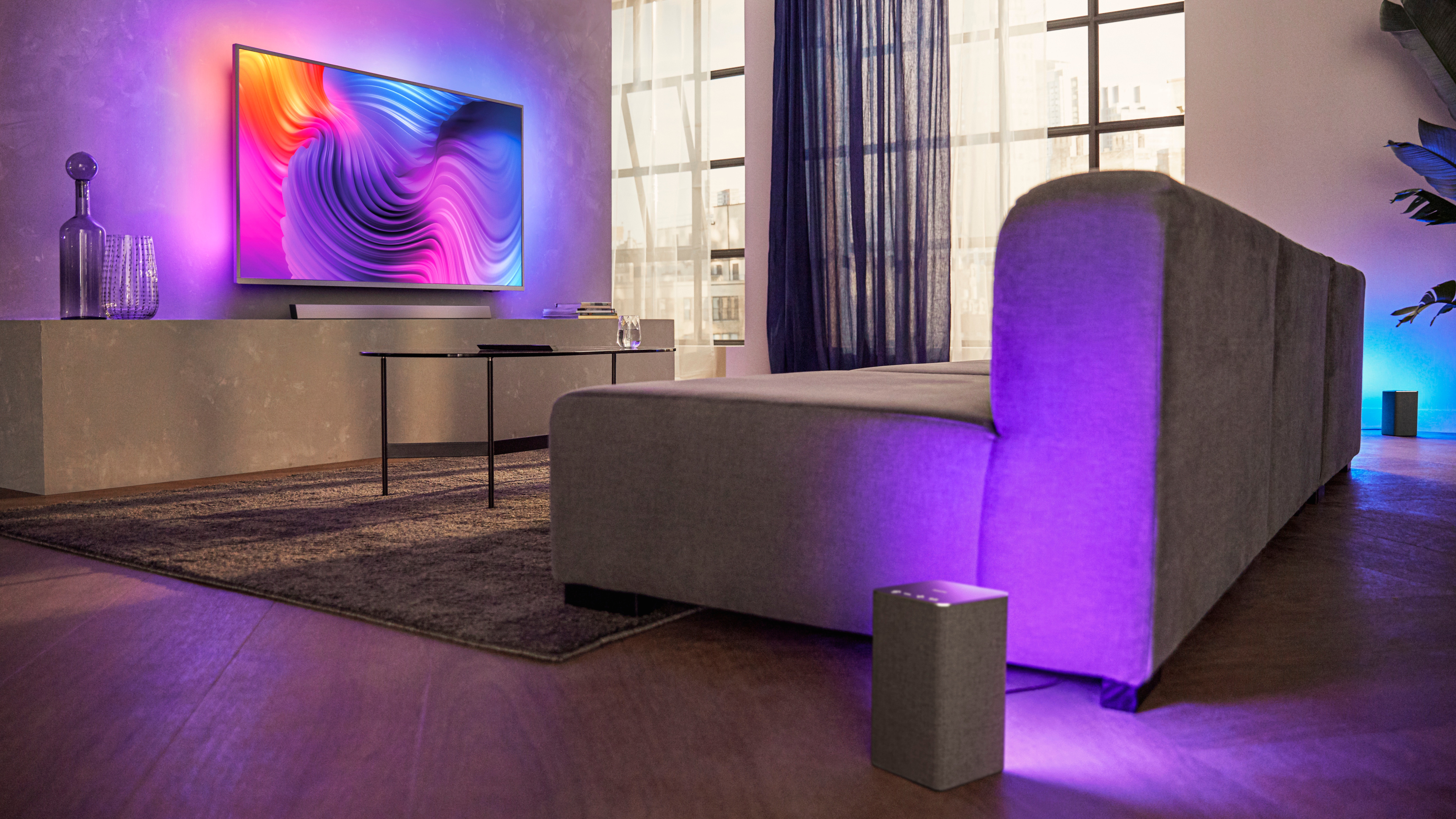
Buy it if...
You want a good all-rounder that’ll work well with all content
This isn’t called “The One” for no reason. Philips has balanced out this TV’s strengths and capabilities to tick the boxes of the average TV buyer. We tested the 58in version, but it’s available in lots of sizes to sort all sorts of situations.
You’re looking for a big screen TV under £1000
This TV offers superb value for money, not only in its performance but in its spec sheet too. It’s great to see both Dolby Vision and HDR10+ supported, plus features like HDMI 2.1/eARC and Dolby Atmos.
You love Ambilight
We do, and it remains a big strength in Philips’ corner. The three-sided Ambilight here works wonders with TV, movies and games.
Don't buy it if...
You’re not keen to compromise on picture quality
Its mid-range price should tell you this, but there are some compromises to be made in picture quality, mostly with HDR footage. In particular, shadow and highlight detail can be lost in the very darkest and lightest areas of a picture, and overall peak brightness could be brighter.
You want the very best out-of-the-box performance
You’re going to need to tweak this Philips TV to get the best from it, and those settings menus go on… and on…
You want to wall mount your TV
At 8cm deep, it’s on the thick side for wall mounting – though not impossible if you don’t mind it sitting a little proud.
- Looking to save even more on a new telly? Check out our guide to the best Black Friday TV deals 2021

Verity is a freelance technology journalist, with previous on-staff roles at What Hi-Fi?, Stuff, Pocket-lint and MSN.
Having chalked up more than 15 years in the industry, she has covered the highs and lows across the breadth of consumer tech, sometimes travelling to the other side of the world to do so. With a specialism in audio and TV, however, it means she's managed to spend a lot of time watching films and listening to music in the name of "work".
You'll occasionally catch her on BBC Radio commenting on the latest tech news stories, and always find her in the living room, tweaking terrible TV settings at parties.
